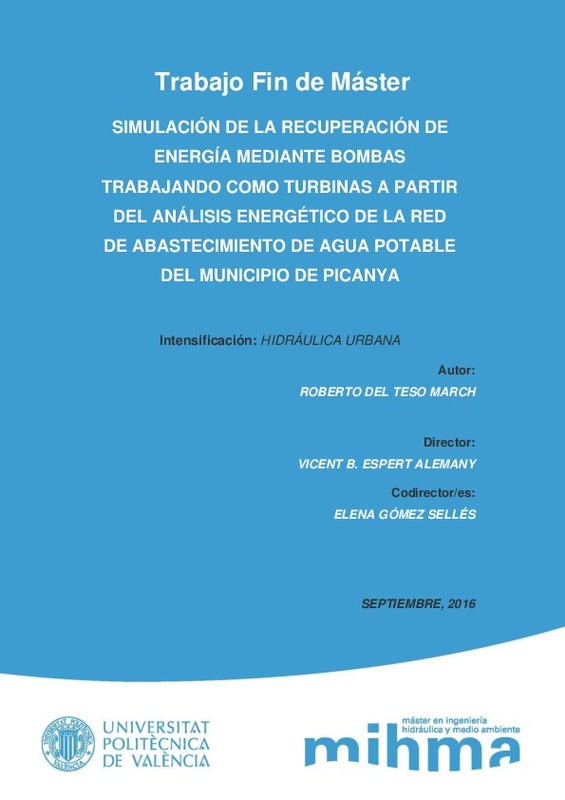JavaScript is disabled for your browser. Some features of this site may not work without it.
Buscar en RiuNet
Listar
Mi cuenta
Estadísticas
Ayuda RiuNet
Admin. UPV
Simulación de la recuperación de energía mediante bombas trabajando como turbinas a partir del análisis energético de la red de abastecimiento de agua potable del municipio de Picanya
Mostrar el registro sencillo del ítem
Ficheros en el ítem
| dc.contributor.advisor | Espert Alemany, Vicent B.
|
es_ES |
| dc.contributor.author | Del Teso March, Roberto
|
es_ES |
| dc.date.accessioned | 2016-11-25T11:35:39Z | |
| dc.date.available | 2016-11-25T11:35:39Z | |
| dc.date.created | 2016-09-23 | |
| dc.date.issued | 2016-11-25 | es_ES |
| dc.identifier.uri | http://hdl.handle.net/10251/74620 | |
| dc.description.abstract | [EN] This final Project was designed to show the importance of energy efficiency in urban water distribution systems, and the possibility of using Pumps As Turbines (PATs) as means to this end. For that reason the focus of the study is on the Picanya water distribution network. The water supply of the town is done by direct connection to the metropolitan core network, this makes the pressure excessive, and because of this, there is a pressure reducing valve (PRV) which helps to bring the pressures required in the municipality. After doing an identification of the consumed flow rates and a characterization of the network, an energy audit of the distribution system was performed. That audit concludes that one way to improve the energy efficiency of the system would be recovering the energy dissipated by the VRP located at the head. For this reason, it was decided to install in parallel with the VRP a pump operating as a turbine. The simulation of the energy recovery was performed by ALLIEVI software, which is able to show a model of a pump working as a turbine through universal curves leading implemented. Once the model of the net was created, different operating points were tested until finding the one that allowed the highest energy recovery with proper operation of the system. Once this was done, different scenarios were simulated and studied, such as: an increase in the inlet pressure from the metropolitan core network and the elimination of the VRP in order that at all times the volume can flow through the pump. Finally, the study of the Picanya water distribution network used to draw conclusions. | es_ES |
| dc.description.abstract | [ES] Con el presente Trabajo Final de Máster se pretende poner de manifiesto la importancia de la eficiencia energética en los sistemas de distribución de agua urbana, y la posibilidad de utilizar bombas trabajando como turbinas (PATs) como medio para llegar a tal fin. Para ello, el trabajo se centra en el estudio de la red de distribución de agua potable del municipio de Picanya. El suministro de agua de esta localidad se realiza mediante conexión directa a la red básica metropolitana, esto hace que la presión en cabecera sea excesiva, existiendo una válvula reductora de presión (VRP) que permite adecuar las presiones a las requeridas en el municipio. Tras un análisis preliminar basado en la identificación de caudales consumidos, y en la caracterización de la propia red, se realiza la auditoría energética de este sistema de distribución. De dicha auditoría se concluye que una manera de mejorar la eficiencia energética del sistema sería recuperando la energía disipada por la VRP situada en cabecera. Para ello se decide instalar en paralelo a la VRP una bomba funcionando como turbina. La simulación de este posible escenario de recuperación de energía se realiza mediante el software ALLIEVI, el cual permite modelizar el funcionamiento de la bomba trabajando como turbina a través de las curvas universales que lleva implementadas. Una vez realizado el modelo de la red, se prueban diferentes puntos de funcionamiento de la bomba hasta conseguir aquel que permita una mayor recuperación de energía junto a un correcto funcionamiento del sistema. Una vez hecho esto, se simulan y estudian diferentes escenarios hipotéticos como son: un aumento en la presión de entrada desde la red básica metropolitana y la eliminación de la VRP para que en todo momento el caudal circule por la bomba. Por último, se obtendrán una serie de conclusiones de este estudio realizado en la red de distribución de agua potable de Picanya. | es_ES |
| dc.language | Español | es_ES |
| dc.publisher | Universitat Politècnica de València | es_ES |
| dc.rights | Reserva de todos los derechos | es_ES |
| dc.subject | Pumps working as turbines (PATs) | es_ES |
| dc.subject | Energy recovery | es_ES |
| dc.subject | Energy efficiency | es_ES |
| dc.subject | Pressure reducing valve (PRV) | es_ES |
| dc.subject | Water distribution systems | es_ES |
| dc.subject | Bombas trabajando como turbinas (PATs) | es_ES |
| dc.subject | Recuperación de energía | es_ES |
| dc.subject | Eficiencia energética | es_ES |
| dc.subject | Válvula reductora de presión (VRP) | es_ES |
| dc.subject | Red de distribución de agua | es_ES |
| dc.subject.classification | INGENIERIA HIDRAULICA | es_ES |
| dc.subject.other | Máster Universitario en Ingeniería Hidráulica y Medio Ambiente-Màster Universitari en Enginyeria Hidràulica i Medi Ambient | es_ES |
| dc.title | Simulación de la recuperación de energía mediante bombas trabajando como turbinas a partir del análisis energético de la red de abastecimiento de agua potable del municipio de Picanya | es_ES |
| dc.type | Tesis de máster | es_ES |
| dc.rights.accessRights | Abierto | es_ES |
| dc.contributor.affiliation | Universitat Politècnica de València. Departamento de Ingeniería Hidráulica y Medio Ambiente - Departament d'Enginyeria Hidràulica i Medi Ambient | es_ES |
| dc.description.bibliographicCitation | Del Teso March, R. (2016). Simulación de la recuperación de energía mediante bombas trabajando como turbinas a partir del análisis energético de la red de abastecimiento de agua potable del municipio de Picanya. http://hdl.handle.net/10251/74620 | es_ES |
| dc.description.accrualMethod | TFGM | es_ES |
| dc.relation.pasarela | TFGM\51501 | es_ES |






